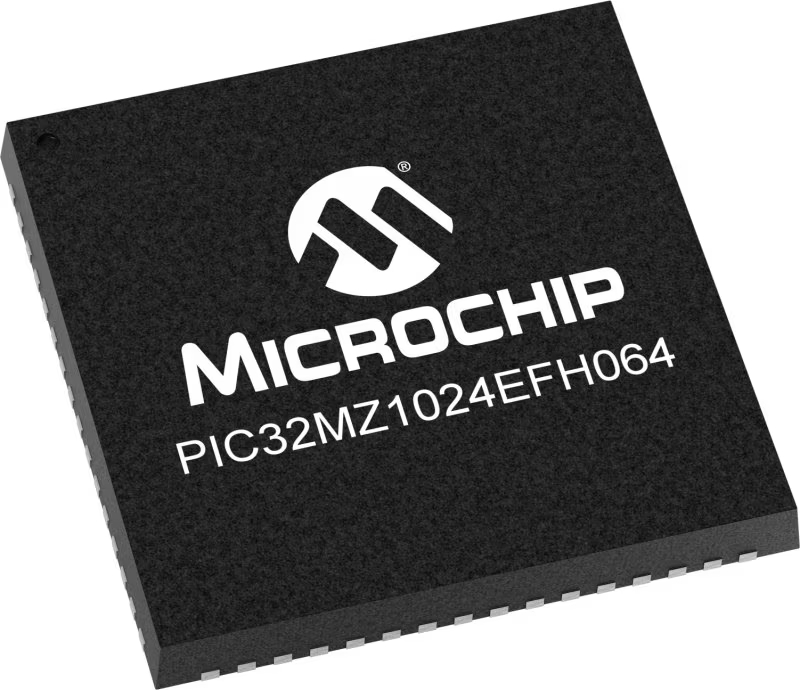释放这款高性能时间数字转换器的无限可能。
A
A
硬件概览
它是如何工作的?
TDC 2 Click 基于 AS6500,这是一款来自 ScioSense 的高分辨率时间数字转换器,具有 CMOS 输入、高测量性能和高数据吞吐量。AS6500 可以在所有四个 STOP 通道上以 10ps 的分辨率测量低至 5ns 的时间间隔,采样率高达 1.5Ms/s。它具有高度的配置灵活性、0 到 16s 的宽测量范围,以及通过校准结果实现的简单数据后处理。它计算相对于应用的参考时钟的校准停止测量。这款 Click board™ 非常适合光学应用,包括一维、二维和三维的通用激光距离测量、速度控制、对象识别、飞行时间光谱等。施加在 STOP 端子(1-4)上的停止信号的正沿相对于前面的参考时钟沿进行测量。参考时钟可以
通过中间端子的 CLR 引脚外部引入,也可以来自板载 8MHz 石英振荡器。此功能可通过软件寄存器设置选择。参考时钟代表所有时间测量的框架,并作为通用时间基准。TDC 连续测量时钟脉冲作为 STOP 脉冲和内部参考周期的时间参考点。STOP 事件的测量始终参考前面的参考时钟。参考时钟连续计数,实际计数作为参考索引分配给 STOP 脉冲。TDC 2 Click 通过标准 SPI 接口与主机 MCU 通信,以读取数据和配置前端,支持高达 50MHz 的高时钟速度和最常见的 SPI 模式,SPI 模式 1。SPI 引脚还使用中断引脚,向主机 MCU 指示数据已准备好处理。AS6500 使用 mikroBUS™ 插座上的几个信号进行成功
的时间测量。使用 RIR 引脚,将参考索引的内部计数器重新设置为零,简化输出数据流中参考索引的概览。接下来,将标记为 DIS 的禁用引脚设置为高逻辑状态,禁用所有四个停止通道的测量。另一方面,参考时钟不受影响,内部参考测量继续。除了 mikroBUS™ 插座外,这些信号还可以在中间接头上找到,与参考时钟引脚分组。此 Click board™ 只能在 3.3V 逻辑电压水平下运行。在使用具有不同逻辑电平的 MCU 之前,板必须进行适当的逻辑电压电平转换。此外,该 Click board™ 配备了包含易于使用的函数和示例代码的库,可作为进一步开发的参考。
功能概述
开发板
PIC32MZ Clicker 是一款紧凑型入门开发板,它将 Click 板™的灵活性带给您喜爱的微控制器,使其成为实现您想法的完美入门套件。它配备了一款板载 32 位带有浮点单元的 Microchip PIC32MZ 微控制器,一个 USB 连接器,LED 指示灯,按钮,一个 mikroProg 连接器,以及一个用于与外部电子设备接口的头部。得益于其紧凑的设计和清晰易识别的丝网标记,它提供了流畅且沉浸式的工作体验,允许在任
何情况下、任何地方都能访问。PIC32MZ Clicker 开 发套件的每个部分都包含了使同一板块运行最高效的必要组件。除了可以选择 PIC32MZ Clicker 的编程方式,使用 USB HID mikroBootloader 或通过外部 mikroProg 连接器为 PIC,dsPIC 或 PIC32 编程外,Clicker 板还包括一个干净且调节过的开发套件电源供应模块。USB Micro-B 连接可以提供多达 500mA 的电流,这足以操作所有板载和附加模块。所有
mikroBUS™ 本身支持的通信方法都在这块板上,包 括已经建立良好的 mikroBUS™ 插槽、重置按钮以及若干按钮和 LED 指示灯。PIC32MZ Clicker 是 Mikroe 生态系统的一个组成部分,允许您在几分钟内创建新的应用程序。它由 Mikroe 软件工具原生支持,得益于大量不同的 Click 板™(超过一千块板),其数量每天都在增长,它涵盖了原型制作的许多方面。
微控制器概述
MCU卡片 / MCU

建筑
PIC32
MCU 内存 (KB)
1024
硅供应商
Microchip
引脚数
64
RAM (字节)
524288
使用的MCU引脚
mikroBUS™映射器
“仔细看看!”
Click board™ 原理图

一步一步来
项目组装
实时跟踪您的结果
应用程序输出
1. 应用程序输出 - 在调试模式下,“应用程序输出”窗口支持实时数据监控,直接提供执行结果的可视化。请按照提供的教程正确配置环境,以确保数据正确显示。

2. UART 终端 - 使用UART Terminal通过USB to UART converter监视数据传输,实现Click board™与开发系统之间的直接通信。请根据项目需求配置波特率和其他串行设置,以确保正常运行。有关分步设置说明,请参考提供的教程。

3. Plot 输出 - Plot功能提供了一种强大的方式来可视化实时传感器数据,使趋势分析、调试和多个数据点的对比变得更加直观。要正确设置,请按照提供的教程,其中包含使用Plot功能显示Click board™读数的分步示例。在代码中使用Plot功能时,请使用以下函数:plot(insert_graph_name, variable_name);。这是一个通用格式,用户需要将“insert_graph_name”替换为实际图表名称,并将“variable_name”替换为要显示的参数。

软件支持
库描述
该库包含 TDC 2 Click 驱动程序的 API。
关键功能:
tdc2_read_results- TDC 2 结果数据读取功能tdc2_start_measuring- TDC 2 开始测量功能tdc2_set_resolution- TDC 2 设置分辨率功能
开源
代码示例
完整的应用程序代码和一个现成的项目可以通过NECTO Studio包管理器直接安装到NECTO Studio。 应用程序代码也可以在MIKROE的GitHub账户中找到。
/*!
* @file main.c
* @brief TDC 2 Click example
*
* # Description
* This library contains API for TDC 2 Click driver.
* The library initializes and defines the SPI bus drivers to
* write and read data from registers, as well as the default
* configuration for a reading time between two STOP signals.
*
* The demo application is composed of two sections :
*
* ## Application Init
* Initializes the driver after that resets the device and
* performs default configuration and sets the device in read mode.
*
* ## Application Task
* This example demonstrates the use of the TDC 2 Click board by
* measuring the time between two STOP signals. This example is set up to
* generate stop signals until FIFO fil's up which is indicated by interrupt pin going to low state.
* After that FIFO buffer is completely emptied by reading, and that data is used to calculate
* the time between STOP signals.
*
* @note
* In order to test this example, you will need to connect STOP1 with the DIS pin. Disable pin is
* disabled by software and it isn't going to affect the working state of the TDC 2 Click Bord.
*
* @author Stefan Ilic
*
*/
#include "board.h"
#include "log.h"
#include "tdc2.h"
static tdc2_t tdc2;
static log_t logger;
/**
* @brief Dev generate stop signal function.
* @details This function generates the stop signal by toggling DIS pin.
* @param[out] cfg : Click configuration structure.
* See #tdc2_cfg_t object definition for detailed explanation.
* @return Nothing.
* @note DIS pin ( Disable STOP channels) is disabled by software and isn't affecting the example.
*/
void dev_generate_stop( tdc2_t *ctx );
void application_init ( void )
{
log_cfg_t log_cfg; /**< Logger config object. */
tdc2_cfg_t tdc2_cfg; /**< Click config object. */
/**
* Logger initialization.
* Default baud rate: 115200
* Default log level: LOG_LEVEL_DEBUG
* @note If USB_UART_RX and USB_UART_TX
* are defined as HAL_PIN_NC, you will
* need to define them manually for log to work.
* See @b LOG_MAP_USB_UART macro definition for detailed explanation.
*/
LOG_MAP_USB_UART( log_cfg );
log_init( &logger, &log_cfg );
log_info( &logger, " Application Init " );
// Click initialization.
tdc2_cfg_setup( &tdc2_cfg );
TDC2_MAP_MIKROBUS( tdc2_cfg, MIKROBUS_1 );
if ( SPI_MASTER_ERROR == tdc2_init( &tdc2, &tdc2_cfg ) )
{
log_error( &logger, " Communication init." );
for ( ; ; );
}
if ( TDC2_ERROR == tdc2_default_cfg ( &tdc2 ) )
{
log_error( &logger, " Default configuration." );
for ( ; ; );
}
tdc2_start_measuring ( &tdc2 );
log_info( &logger, " Application Task " );
}
void application_task ( void )
{
uint32_t reference_index [ 18 ] = { 0 };
uint32_t stop_result [ 18 ] = { 0 };
uint8_t cnt = 0;
tdc2_reset_index( &tdc2 );
Delay_ms( 10 );
while ( tdc2_get_int_state( &tdc2 ) == 1 )
{
dev_generate_stop( &tdc2 );
Delay_ms( 100 );
}
while ( tdc2_get_int_state( &tdc2 ) == 0 )
{
tdc2_read_results( &tdc2, TDC2_REG_INDEX_CH1_BYTE3, &reference_index[ cnt ], &stop_result[ cnt ] );
log_printf( &logger, "CH1: Reference Index[%d]: %lu, Stop Result[%d]: %lu \r\n", ( uint16_t ) cnt,
reference_index[ cnt ], ( uint16_t ) cnt, stop_result[ cnt ] );
Delay_ms( 10 );
if ( cnt )
{
uint32_t time = 0;
tdc2_get_time_between_stops ( &tdc2, stop_result[ cnt - 1 ], reference_index[ cnt - 1 ],
stop_result[ cnt ], reference_index[ cnt ], &time );
log_printf( &logger, "Time between STOP %d and STOP %d is %lu ms \r\n",
( uint16_t ) ( cnt - 1 ), ( uint16_t ) cnt, time / TDC2_uS_TO_mS );
Delay_ms( 10 );
}
cnt++;
}
log_printf( &logger, "---------------------------------------------- \r\n" );
}
void main ( void )
{
application_init( );
for ( ; ; )
{
application_task( );
}
}
void dev_generate_stop( tdc2_t *ctx )
{
digital_out_high( &ctx->dis );
Delay_ms( 1 );
digital_out_low( &ctx->dis );
}
// ------------------------------------------------------------------------ END

































